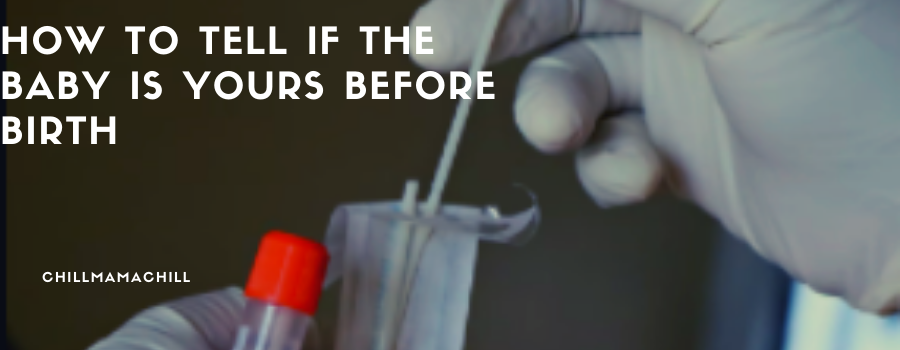It’s an uncomfortable question, and one that men have been asking for ages, especially when given the news they’re soon-to-be dads. But except for her say so, do you have to wait until the child is born to know if you’re the father? Are there methods on how to tell if the baby is yours before birth?
Non-invasive DNA sequencing and analysis can determine if the baby is yours as early as the eighth or ninth week of pregnancy. Using SNP or Single-Nucleotide Polymorphism, a blood sample from the mother and a cheek swab from the potential father are taken to give 99.9% certainty of paternity. The test is safe for the mother and unborn child, without the invasive risks of amniotic fluid leakages or miscarriage.
Without DNA testing, it’s almost impossible to tell if the baby is yours, especially before the birth. There are also invasive, in-utero tests like chorionic villus sampling and amniocentesis, which can be performed from the 10th to the 20th week of pregnancy. To set your mind at ease and eliminate uncertainty, read on to learn how you can know an unborn baby’s paternity before it’s born.
Why Should I Want To Tell If the Baby Is Mine Before Birth?
One of the first questions that come to your mind when your partner informs you of an unexpected pregnancy is to question if you’re the father. Statistics show that over 40% of all births in the US are by single or unmarried mothers. Being married also doesn’t give automatic certainty that you as the husband have sired the baby, besides postpartum paternity testing.

Medical technology has provided ways to establish paternity as early as the 3rd month of pregnancy. For legal, psychological, and medical reasons, you can know if the baby is yours without putting the embryo or the mother at risk. Once certain that you’re the father, you’ll be able to support the woman emotionally and financially during the pregnancy, leading to a healthier birth.
It’s necessary to establish paternity for your baby to receive full social and legal benefits. In many states, the father’s name has to be listed on the birth certificate if they’re to get comprehensive healthcare, social security, or inheritance rights. Knowing if you’re the father also helps determine a more accurate family medical history to diagnose potential congenital issues.
According to the current law, any costs associated with pregnancy are the woman’s problems. Once such tests gain legal acceptance, however, she may be able to pursue child support before the baby is born. So, besides educated guesses or mathematical reasoning, now there’s exact science on how to tell if the baby is yours before birth.
How Does Prenatal Non-Invasive Paternity Testing Work?
Not knowing if you’re the father of an unborn child can be stressful, and that’s extended by months if you have to wait until the baby is born. You’ll be able to make relationship decisions way before the tot comes to make matters complicated, and you can get involved in preparing for the birth. Besides, you’ll have time to get all the legal ducks in a row for custody, child support, and such.
Prenatal paternity testing also ensures that any congenital disorders of your lineage could have been checked and arrested. The test is performed as early as seven to nine weeks of pregnancy, meaning you can confirm if you’re the father almost immediately. There are no risks for the baby or its mother, unlike outdated, and uterine invasive determinants like Chorionic Villus Sampling or CVS and amniocentesis.
Microarray technology called single-nucleotide polymorphism or SNP analyzes free-floating fetal DNA present in the mother’s plasma, comparing it to her profile. A simple blood sample draw accomplishes this, while for you the father, a cheek swab, hair, or blood sample will suffice. Results for the analysis are available at most one week, and there’s 0 probability of paternity if you aren’t the dad, compared to 99.9% if you are.
The only drawback to SNP is when the woman is carrying twins since free-floating DNA will belong to both fetuses. Currently, microarray technology can’t isolate each of the fetuses’ profiles separately. It’s also important to note that laboratories that perform these diagnostics aren’t equally equipped, or accredited, so do some research before settling on one choice.
What Other In-Utero Tests Can I Get To Ascertain Paternity of an Unborn Baby?
Besides Non-Invasive Prenatal Paternity testing or NIPP, there are invasive methods of telling if the baby is yours before birth. These tests are used to check fetuses for congenital disorders like Down syndrome, using chorionic villus sampling and amniocentesis. But these procedures, seeing as they rely on analysis of amniotic fluid, carry a minimal risk of inducing miscarriage.
Chorionic Villus Sampling, CVS
A thin tube or needle is inserted into the pregnant woman’s vagina to reach the uterus through the cervix in chorionic villus sampling. The laboratory technician uses ultrasound as a guide to collect small uterine wall tissue called chorionic villi. These samples are then analyzed for their genetic makeup since it resembles that of the growing fetus.
With the DNA collected from you or other potential fathers, there’s a 99% accuracy rate for paternity proof using CVS. The procedure is performed between ten and 13 weeks of pregnancy and is used to detect genetic or chromosomal abnormalities. To perform chorionic villus sampling, your doctor requires giving consent seeing as one in 100 of these procedures results in miscarriage.
Amniocentesis
An amniocentesis test can be performed between the 14th and 20th week of pregnancy. The procedure typically involves taking a sample of the amniotic fluid from the uterus using a long thin needle piercing the stomach. It’s a process typically used to detect genetic or chromosomal disorders, as well as neural tube defects.
Results of amniocentesis are 99% accurate when the DNA collected is compared to yours or other alleged fathers. Risks involved with this procedure include premature labor, infection, or water breaking to induce miscarriage. Other side effects of this invasive process include vaginal bleeding, amniotic fluid leaks, and cramping or injection site irritation. Consent from your doctor is mandatory should you choose to have the process done for paternity testing.
Conclusion
Depending on whatever reason you have, you now know how to tell if a baby is yours before birth. However, don’t trust the fate of the unborn child to any run-of-the-mill laboratory, but instead, choose one accredited by the American Association of Blood Banks or AABB. These institutions practice stringent standards for diagnostics and test performances, recommended by the American Pregnancy Association.

I’m Cathrine and I’m a 39-year-old mother of 3 from Utica, New York. And I’m extremely happy you’ve come to visit my hide-out on the web. Here I post about everything related to family-life and usually it will involve babies and lessons I’ve learned over the years from experts, friends, and my own mistakes. So hopefully you will find what i write fun and informational!

